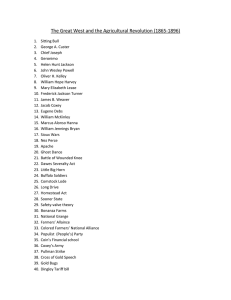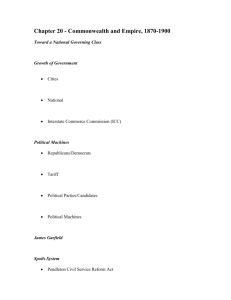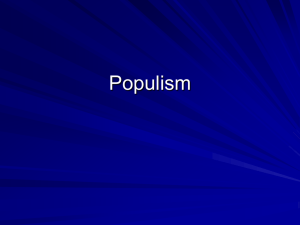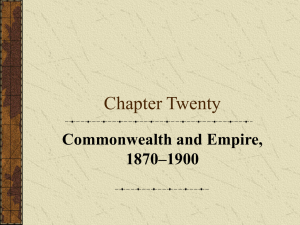Politics and Government, 1877-1900 Lecture/Reading Notes 4 (p. 122-125)
advertisement
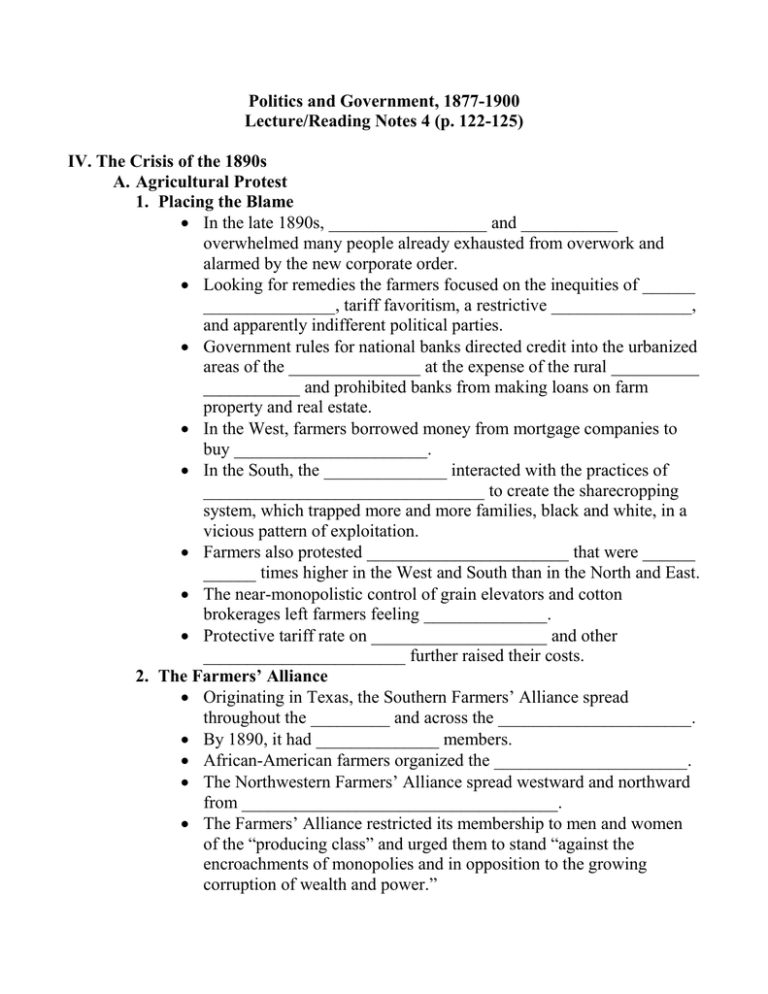
Politics and Government, 1877-1900 Lecture/Reading Notes 4 (p. 122-125) IV. The Crisis of the 1890s A. Agricultural Protest 1. Placing the Blame In the late 1890s, __________________ and ___________ overwhelmed many people already exhausted from overwork and alarmed by the new corporate order. Looking for remedies the farmers focused on the inequities of ______ _______________, tariff favoritism, a restrictive ________________, and apparently indifferent political parties. Government rules for national banks directed credit into the urbanized areas of the _______________ at the expense of the rural __________ ___________ and prohibited banks from making loans on farm property and real estate. In the West, farmers borrowed money from mortgage companies to buy ______________________. In the South, the ______________ interacted with the practices of ________________________________ to create the sharecropping system, which trapped more and more families, black and white, in a vicious pattern of exploitation. Farmers also protested _______________________ that were ______ ______ times higher in the West and South than in the North and East. The near-monopolistic control of grain elevators and cotton brokerages left farmers feeling ______________. Protective tariff rate on ____________________ and other _______________________ further raised their costs. 2. The Farmers’ Alliance Originating in Texas, the Southern Farmers’ Alliance spread throughout the _________ and across the ______________________. By 1890, it had ______________ members. African-American farmers organized the ______________________. The Northwestern Farmers’ Alliance spread westward and northward from ____________________________________. The Farmers’ Alliance restricted its membership to men and women of the “producing class” and urged them to stand “against the encroachments of monopolies and in opposition to the growing corruption of wealth and power.” The Alliance attempted to establish farmers’ cooperatives to _______ ________________ and developed ingenious proposals to remedy rural ______________________ problems. B. The People’s Party, In the West, ____________________ organized independent third parties, which eventually adopted the labels “People’s” or “Populist.” The founders of the Kansas People’s Party, including members of the Farmers’ Alliance, ________________, ____________, and the old Greenback Party, launched a campaign marked by grim determination and fierce rhetoric. Populist parties gained control of the legislatures of ___________________ and won congressional elections in ________________________________. In the mountain states, where there support came from more miners than farmers, they won governorships in _______________________________. On the Pacific coast, angry farmers found allies among _____________ and the Populists elected a __________________, _______________________, and legislators in both states. In Oklahoma, the Populist party drew support from ____________________ ______________, in Arizona, from __________________________. In New Mexico, the Southern Alliance established itself among __________ ___________ who felt threatened by _______________________________. In the South, the Alliance did not initially form third parties but instead swept “__________________” into office, electing four governors, several dozen members of Congress, and a majority of legislators in eight states. With their new political power, farmers enacted reform legislation in many Western states. New laws _________________________and protected poor debtors by capping interest rates and restricting mortgage foreclosures. Others protected _______________________________________________. Populists met in Omaha, Nebraska, on July 4, 1892, to organize a national party and nominated former Greenbacker ________________ for president. The party platform, known as the ____________, rejected laissez-faire policies of the old parties and declared: “We believe that the powers of government – in other words, of the people, should be expanded…to the end that oppression, injustice and poverty shall eventually _________________. The platform demanded government ownership of the _________________ ________________________; a national currency issued by the government rather than private banks; the sub-treasury system; ____________________ ________________; __________________________; and the redistribution to settlers of land held by ____________________________________. C. The Challenge of the Depression A harsh and lengthy depression began in _______, worsening conditions for ___________________________________. The failure of the major parties to respond to serious problems swelled __________________________. Almost oblivious to the mounting demand for reform, Grover Cleveland delivered an inaugural address championing the doctrine of _____________ and rejecting government action to solve ____________________________. Most _______________________________ beyond encouraging private charity to the homeless. 1. Jacob Coxey and the march on Washington Jacob Coxey proposed _______________________________ for the unemployed to be financed with paper money. This plan would improve the nation’s infrastructure, ______________ _________________, and provide an inflationary stimulus to counteract the depression’s deflationary effects. Coxey organized a march of the unemployed to Washington as “____ ________________________” to support his ideas. Despite public sympathy for Coxey, the government acted to suppress him. When he reached Washington with ____________, police and soldiers arrested him and his aides, ___________________ in a crowd of ________________ and herded the marchers into detention camps. 2. Federal rejection of the demand for reform The depression also provoked labor turmoil. There were some ______ industrial strikes involving nearly __________ workers in 1894. In a series of decisions in 1895, the Supreme Court strengthened the bonds between ______________________. First it upheld the use of a court ordered injunction to break the ____________. The Court gutted the Sherman Antitrust Act by ruling that manufacturing, as opposed to commerce, was beyond the reach of federal regulation. Finally, the Court invalidated an _______________ that agrarian Democrats and Populists had maneuvered through Congress as an “assault upon capital.” Cleveland blamed the economic collapse on the _________________ _______________, which he regarded as detrimental to business confidence and a threat to the nation’s gold reserve. By 1894, the Treasury had begun borrowing money from __________ to bolster the ________________. D. The Battle of the Standards and the Election of 1896 To undercut the _______________ and to distance themselves and their party from the despised Cleveland, leading Democrats began using the ________________ to reorganize their party. ________________________, governor of Ohio and author of the McKinley Tariff of 1890, emerged as the leader of a crowd of hopeful Republican presidential candidates. Their platform called for ________________ but also endorsed the ___________________, placating Eastern delegates but prompting several _______________________ to withdraw from their party. The Democrats adopted a platform that repudiated the Cleveland administration and its policies and endorsed free silver, the income tax, and tighter regulation of trusts and railroads. A magnificent speech by ________ _________________ helped convince the delegates to nominate him for president. The ________________ also nominated Bryan. The campaign was intense and dramatic. Eastern financial and business interests contributed millions of dollars for McKinley. Standard Oil provided $_______________, about the same amount as the Democrats’ total national expenses. The Democrats relied on Bryan’s superb voice and youthful energy. Bryan was the first candidate to _________________________________, speaking hundreds of times to millions of voters. McKinley stayed at home in Canton, Ohio, where he conducted a “front porch” campaign. The intense campaign brought a record voter turnout and McKinley won decisively by capturing the ______________________ as well as Oregon and California. Bryan carried the traditionally Democratic __________ and the _____________________ states where Populists and silverites dominated. McKinley plunged into his presidency. He had a definite program consisting of __________________, __________________, and _________________. With the return of prosperity and the decline of social tensions, McKinley easily won reelection in 1900, defeating ______________________.
